- News
- Reviews
- Bikes
- Components
- Bar tape & grips
- Bottom brackets
- Brake & gear cables
- Brake & STI levers
- Brake pads & spares
- Brakes
- Cassettes & freewheels
- Chains
- Chainsets & chainrings
- Derailleurs - front
- Derailleurs - rear
- Forks
- Gear levers & shifters
- Groupsets
- Handlebars & extensions
- Headsets
- Hubs
- Inner tubes
- Pedals
- Quick releases & skewers
- Saddles
- Seatposts
- Stems
- Wheels
- Tyres
- Tubeless valves
- Accessories
- Accessories - misc
- Computer mounts
- Bags
- Bar ends
- Bike bags & cases
- Bottle cages
- Bottles
- Cameras
- Car racks
- Child seats
- Computers
- Glasses
- GPS units
- Helmets
- Lights - front
- Lights - rear
- Lights - sets
- Locks
- Mirrors
- Mudguards
- Racks
- Pumps & CO2 inflators
- Puncture kits
- Reflectives
- Smart watches
- Stands and racks
- Trailers
- Clothing
- Health, fitness and nutrition
- Tools and workshop
- Miscellaneous
- Buyers Guides
- Features
- Forum
- Recommends
- Podcast
review
£3,699.99
VERDICT:
The Vitesse Evo delivers heaps of performance thanks to a great frameset and component choice, at a good price
Excellent groupset and choice of gear ratios
Balanced handling
Prime handlebar is stiff and harsh
The saddle shape won't suit all
Weight:
8,000g
Contact:
At road.cc every product is thoroughly tested for as long as it takes to get a proper insight into how well it works. Our reviewers are experienced cyclists that we trust to be objective. While we strive to ensure that opinions expressed are backed up by facts, reviews are by their nature an informed opinion, not a definitive verdict. We don't intentionally try to break anything (except locks) but we do try to look for weak points in any design. The overall score is not just an average of the other scores: it reflects both a product's function and value – with value determined by how a product compares with items of similar spec, quality, and price.
What the road.cc scores meanGood scores are more common than bad, because fortunately good products are more common than bad.
- Exceptional
- Excellent
- Very Good
- Good
- Quite good
- Average
- Not so good
- Poor
- Bad
- Appalling
The Vitesse Evo Team eTap AXS is described as a true pro race bike by Vitus and boy oh boy, does it ever ride like one. The frame is great, not only in the way it delivers the ride quality but also in terms of handling, and the SRAM groupset is the icing on the cake. With a few component tweaks it'd be nigh-on perfect in my eyes.
Ride
The Vitesse Evo Team is a lovely bike to ride. With a low front end, the riding position feels purposeful and aggressive, and thanks to loads of stiffness in the lower half of the frame it's a bike you can really ride hard.
Its overall weight of 8kg is light by disc brake bike standards and the whole package feels very responsive.
The wide BB386 Evo bottom bracket junction, oversized down tube and chunky chainstays mean that the Vitesse wastes nothing when accelerating hard from a standstill, going for a sprint or attacking a climb out of the saddle, and you can see why the Vitesse Evo is the bike used by the Vitus Pro Cycling team.
As you'd expect on a bike with these sort of racing intentions, the fork is full carbon fibre with the steerer tapered to correspond with the oversized head tube. This means the front end feels really tight and direct when steering into technical bends on a descent or when hauling on the front brake for an emergency stop.
The handling on the whole is really well balanced, whether cruising along or really pushing it into the corners. Following a bit of motorpacing behind a lorry and getting caught a couple of times in the turbulent air just outside of the slipstream, the Vitus and I got buffeted about a fair bit, but thanks to that stable handling it was easy to bring back under control at high speed without ever feeling twitchy or out of control.
Alongside the stiffness, Vitus has managed to achieve a decent level of comfort in the frame and fork – just enough to take the edge off the vibration without dialling down on the amount of feedback you are receiving through the contact points. This is what gives you the confidence to ride faster than you probably really should in some instances.
The Vitus isn't all about tearing it around everywhere, though. With the current social distancing measures in place for the test period, five-hour rides to test comfort haven't really been a viable option, but with a bit of route planning I've been able to get in various two to three-hour jaunts on the Vitesse and found the whole experience very pleasurable.
My only two real niggles are that I didn't get on with the shape of the saddle that well and I did find the Prime handlebar really stiff and a little unforgiving in relation to the rest of the bike. These are simple and relatively inexpensive things to change, though, should you want to.
Groupset
The Vitesse Evo is very efficient and while a lot of that is down to the lack of weight and a decent set of wheels and tyres, the SRAM Force eTap AXS groupset also plays a major part.
We don't get a massive amount of eTap-equipped bikes in for testing, and I haven't ridden it that much in the past so I haven't really kept up to date with the ratios you get with the 12-speed offerings. I didn't even look before heading out for the first few rides.
At first I thought I'd simply hit a bit of form, as I was barely dropping out of the big ring except for the steepest of climbs, but even on those I was staying in the saddle pretty much to the top where I'd normally be hanging over the handlebar with drool and sweat dropping onto the front tyre.
> SRAM introduces wide-range gearing for Force eTap AXS groupset
The Vitus has a 48/35-tooth chainset paired to a 10-33t cassette spread over the 12 sprockets, and the range of ratios and how usable they are really makes a massive difference over the gears on my own race bike with its 52/36t chainset and 11-28t cassette.
If you work in gear inches, at the lowest end, the 35x33 is just 28in while the top end 48x10 gives you 127in. Compare that to a more common setup of a compact chainset of 50/34t paired to a 11-28 cassette which gives a low of 32in and a high of 120.4in.
To put that into context: I was still pushing on the pedals at 57mph in the 48x10 – albeit with a cadence of about 153rpm.
SRAM has achieved this large range without making the cassette feel gappy as the smaller sprockets have one-tooth jumps before swapping to two-tooth jumps further up. The jump from the second largest sprocket to the largest is five teeth – 28t to 33 – so that is the only one that breaks your cadence rhythm, but as you'll be using it as a bailout gear it's not really an issue.
If you haven't used SRAM's electronic groupset before, it is one of the most simple ways to change gear you'll ever find. It has buttons where you'd find SRAM's usual mechanical Doubletap system, and you simply push the one on the left lever to select an easier gear on the cassette, and the one on the right to select a harder one. If you want to change from big to small ring or vice versa on the chainset, you just press both buttons together.
The shifting is spot on throughout the range, and thanks to the whole system being wireless it keeps the bike looking smooth and clean. The only slight trade-off is that the front and rear mechs can look a little bulky because they need their own battery packs.
It's also easy to set up, and battery life is very good.
The Vitesse Evo is only available as a disc brake option now, and Vitus has gone with SRAM Force hydraulic braking. Up front the Vitesse uses a 160mm diameter rotor, with that dropping to a 140mm at the rear.
There is an abundance of braking power whatever the conditions, and plenty of feel through the levers to let you know if you've locked the rear wheel up.
Frame and fork
The Vitesse Evo is manufactured from Toray T700 unidirectional carbon fibre throughout.
It's a quality looking frame and well finished around the top of the head tube and seat tube, places that can look a little scruffy around the edges where they have come out of the mould.
As I've mentioned, the front and lower half of the frame is all about stiffness and power transfer.
Vitus has gone for a press-fit bottom bracket, BB386 Evo in this case, which allows for a wider bottom bracket shell of 86.5mm on account of the bearings being placed inboard of the frame rather than externally, like threaded bearing cups on a 68mm wide shell.
The overall width between the cranks remains the same but the wider shell allows for a wider seat tube base, a wider down tube (a colossal 60mm in this case) and larger chainstays for increased stiffness.
As the top tube heads towards the seat tube it tapers in size, and the seatstays are noticeably thinner than the rest of the frame to provide some flex and comfort to the rear end of the frame.
Regardless of what groupset you choose, the Vitesse frames have full internal cable and hose routing.
The Evo uses 12mm thru-axles front and rear, and the brake callipers are flat mount – no real surprise there really as the majority of road bikes have moved away from post mount.
It comes with 25mm tyres as standard with room to go bigger. During testing I swapped another set of wheels in with 28mm tyres and there were no clearance issues.
The bike is available in six sizes, ranging from XS to XXL, with effective top tubes of 515mm through to 595mm. Our test model was a medium which has a top tube of 545mm, 140mm head tube and a wheelbase of 985mm. The stack figure is 548mm with a reach of 382mm.
> Why stack and reach measurements are important
Angle-wise you are looking at 73 degrees for the head tube and 73.5 degrees for the seat tube. Details for all the other sizes can be found on Vitus's website.
Finishing kit
It's quite rare to see an alloy seatpost on a bike at this price, but the Zipp Service Course is a quality piece of kit. It's good to see Vitus has gone for a matching stem, too, though it would have been better if it had continued the theme to the handlebar as well, to give the bike a more complete look.
As I've mentioned, the Prime Doyenne bar is very stiff and I found it a bit harsh at times. I did like the shape, though, with the flat tops giving plenty of room to rest your hands and the shallow depth making the drops easily accessible.
The saddle is a Vitus own with titanium rails. I didn't really gel with it, although it wasn't so bad that I felt the need to change for anything else; I probably would if it was my own bike. Saddle shape and comfort are very subjective things though.
Wheels and tyres
You do get a quality set of carbon fibre wheels thrown in by way of Prime's Black Edition 38. Liam was very impressed when he tested the 50mm rim brake version and I'd agree with his general findings.
The 38s here are obviously disc brake-specific and although they aren't set up tubeless when you purchase the bike, they are compatible, as are the Hutchinson Fusion 5 Performance tyres. Some valves and sealant and you're ready to go.
The 38mm rim depth makes them good all-rounders in a range of conditions without being affected by strong crosswinds.
They are solidly built too, with well tensioned spokes, and trueness wasn't an issue at all, plus they have enough stiffness to complement the good work of the frame and fork.
The Hutchinson tyres offer loads of grip thanks to a tacky compound, and these, along with the feedback of the frame, really add to the confidence when you are tackling the corners at speed. I certainly wouldn't be upgrading until they wore out, and they seem to be pretty robust too.
Value
While £3,699.99 is quite an outlay, you are getting a lot of bike for your money.
I was impressed with the Scott Addict RC 30 when I reviewed it a few months back, but although it is cheaper than the Vitus by £500, it does only come with basic alloy wheels and a Shimano 105 groupset.
> Buyer’s Guide: 14 of 2020's best road bikes under £2,000
Further up the range is the RC 20 which comes with carbon wheels and the same Force eTap AXS groupset found on the Vitesse; that'll set you back £4,399.
> Buyer’s Guide: 15 of the best £2,000-£3,000 road bikes
For me the Vitesse Evo offers similar performance and stiffness to Canyon's Ultimate. Canyon offer a CF SL Disc 8.0 Force eTap with Reynolds carbon wheels for £3,749 for the women's version, while the men's gets Shimano Ultegra Di2 for £3,899.
Conclusion
Overall, the Vitus is a very good bike. I love the way it rides – it's very easy to live with and Vitus has done a great job of balancing stiffness with comfort. Topping the excellent frame and fork off with such good components – a few exceptions aside – works really well, especially considering the overall price.
Verdict
The Vitesse Evo delivers heaps of performance thanks to a great frameset and component choice, at a good price
road.cc test report
Make and model: Vitus Vitesse Evo Team eTap 2020
Size tested: Medium
About the bike
List the components used to build up the bike.
Vitus lists:
Frame Vitesse EVO Disc, UD Carbon T700
Forks Integrated UD carbon
Chainset SRAM Force Carbon - 48.35t
Bottom Bracket SRAM DUB
Shifters SRAM Force eTap AXS Hydraulic
Front Derailleur SRAM Force eTap AXS D1
Rear Derailleur SRAM Force eTap AXS D1
Cassette SRAM 10-33T
Chain SRAM Force D1
Rims PRIME Black Edition 38 Carbon Disc Tubeless
Front Hub Prime
Rear Hub Prime
Spokes
Tyres Hutchinson Fusion 5 Performance Tubeless 700c x 25
Front Brake SRAM Force eTap AXS D1 Hydraulic
Rear Brake SRAM Force eTap AXS D1 Hydraulic
Handlebars Prime Doyene Aluminium
Stem ZIPP Service Course
Headset ACROS AiX
Saddle Vitus Ti Rail
Seatpost ZIPP Service Course
Seatclamp VITUS
Tell us what the bike is for and who it's aimed at. What do the manufacturers say about it? How does that compare to your own feelings about the bike?
Vitus says, "The Vitesse EVO TEAM eTap AXS is the lightest bike in the Vitus range – a true pro race bike. Designed with minimal weight to charge up climbs, efficient stiffness to sprint and accelerate, and all-day comfort to glide through rough road surfaces with minimal fatigue, this bike will leave you fresh to challenge for the finish line.
"We worked collaboratively with the professional UCI Continental Pro cycling team, An-Post CRC throughout the design and test phase of the Vitesse EVO, with a comprehensive testing and feedback programme. This allowed our designers to optimise the Vitesse EVO, achieving the perfect balance of ride characteristics to make this bike competitive in all conditions- from the spring classics to the high mountains of Europe. The Vitesse EVO is a proven, professional race-winning platform, and is the bike of choice for professional team, Vitus Pro cycling in 2020.
"The Vitesse EVO is now a disc brake only frameset, with full internal cable routing, and a UCI certified frame and fork. With semi-compact geometry and lots of flexibility in its set-up, you're guaranteed to get the position you want. The Vitesse EVO is renowned for its composed handling being both balanced and stable, yet nimble enough to pilot through a bunch sprint."
The Vitesse Evo feels like a proper race bike with no sacrifices being made when it comes to the performance.
Where does this model sit in the range? Tell us briefly about the cheaper options and the more expensive options
The Evo Team sits second in the range. The Evo CRX sits above it at £4,999.99, and comes with SRAM Red eTap AXS.
Sitting below are two Evo CRS models, one with Shimano Ultegra Di2 (£3,499.99), the other Ultegra mechanical at £2,499.99. Last but not least is the Evo CR which has Shimano 105, £1,999.99.
Frame and fork
Overall rating for frame and fork
8/10
Tell us about the build quality and finish of the frame and fork?
A very good frame and fork that rides well thanks to the carbon fibre layup. It is well finished and the metallic red paintwork looks great in the sun.
Tell us about the materials used in the frame and fork?
The frame and fork use Toray T700 uni-directional carbon fibre.
Tell us about the geometry of the frame and fork?
The Vitesse Evo is very much in the race bike category with a low front end and reasonably stretched out position. Full geometry charts are on the website.
How was the bike in terms of height and reach? How did it compare to other bikes of the same stated size?
The medium model tested has a stack of 548mm which is quite low thanks to that short head tube. The reach is 382mm. Both measurements tie in with similar race bikes of the same stated size.
Riding the bike
Was the bike comfortable to ride? Tell us how you felt about the ride quality.
Yes. Ride quality overall is very good, with the frameset taking out much of the high frequency road buzz.
Did the bike feel stiff in the right places? Did any part of the bike feel too stiff or too flexible?
Stiffness is very impressive, especially around the lower part of the frame.
How did the bike transfer power? Did it feel efficient?
The Vitesse is very efficient thanks to excellent power transfer at the bottom bracket.
Was there any toe-clip overlap with the front wheel? If so was it a problem?
No, none.
How would you describe the steering? Was it lively neutral or unresponsive? Fast but well balanced.
Tell us some more about the handling. How did the bike feel overall? Did it do particular things well or badly?
The Vitesse Evo handles like a proper race bike. The steering is quick and agile enough to cope with fast corners and high-speed descents without ever feeling twitchy or a handful to control.
Which components had the most effect (good or bad) on the bike's comfort? would you recommend any changes?
I found the saddle and handlebar took away some of the good work being done by the frame in terms of comfort. It was minor, though, and didn't spoil the overall ride, just a few changes I might make if the bike was my own.
Which components had the most effect (good or bad) on the bike's stiffness? would you recommend any changes?
The Prime wheels highlighted plenty of stiffness as did the Force chainset.
Which components had the most effect (good or bad) on the bike's efficiency? would you recommend any changes?
Definitely the ratios of the cassette and the chainset, they add hugely to the efficiency.
Rate the bike for efficiency of power transfer:
9/10
Rate the bike for acceleration:
8/10
Rate the bike for sprinting:
8/10
Rate the bike for high speed stability:
9/10
Rate the bike for cruising speed stability:
9/10
Rate the bike for low speed stability:
8/10
Rate the bike for flat cornering:
9/10
Rate the bike for cornering on descents:
10/10
Rate the bike for climbing:
8/10
The drivetrain
Rate the drivetrain for performance:
8/10
Rate the drivetrain for durability:
8/10
Rate the drivetrain for weight:
8/10
Rate the drivetrain for value:
6/10
Tell us some more about the drivetrain. Anything you particularly did or didn't like? Any components which didn't work well together?
Force eTap AXS is a very simple groupset to use and the performance is very good.
Wheels and tyres
Rate the wheels for performance:
8/10
Rate the wheels for durability:
8/10
Rate the wheels for weight:
8/10
Rate the wheels for comfort:
8/10
Rate the wheels for value:
7/10
Tell us some more about the wheels.Did they work well in the conditions you encountered? Would you change the wheels? If so what for?
A quality set of wheels throughout that really complement the performance of the Vitus's frameset.
Rate the tyres for performance:
8/10
Rate the tyres for durability:
8/10
Rate the tyres for weight:
7/10
Rate the tyres for comfort:
8/10
Rate the tyres for value:
6/10
Tell us some more about the tyres. Did they work well in the conditions you encountered? Would you change the tyres? If so what for?
Impressive grip levels and they roll very well.
Controls
Rate the controls for performance:
7/10
Rate the controls for durability:
8/10
Rate the controls for weight:
7/10
Rate the controls for comfort:
6/10
Rate the controls for value:
6/10
Tell us some more about the controls. Any particularly good or bad components? How would the controls work for larger or smaller riders?
The scores take into account that I had a few personal issues with comfort from the saddle and handlebar. On the whole though, it is a good selection of finishing kit.
Your summary
Did you enjoy riding the bike? Yes
Would you consider buying the bike? Yes
Would you recommend the bike to a friend? Yes
How does the price compare to that of similar bikes in the market, including ones recently tested on road.cc?
For the overall package, the Vitus stands up well against some very good competition, like the Scott and Canyon I mention in the review.
Rate the bike overall for performance:
9/10
Rate the bike overall for value:
7/10
Use this box to explain your overall score
Apart from a couple of small component choices, I think the Vitesse Evo Team is a very good all-round package. It has a quality frameset at its heart, which benefits from a great groupset and top notch wheels and tyres.
About the tester
Age: 41
I usually ride: This month's test bike My best bike is: B'Twin Ultra CF draped in the latest bling test components
I've been riding for: Over 20 years I ride: Every day I would class myself as: Expert
I regularly do the following types of riding: time trialling, commuting, club rides, sportives, fixed/singlespeed,
Since writing his first bike review for road.cc back in early 2009 senior product reviewer Stu has tested more than a thousand pieces of kit, and hundreds of bikes.
With an HND in mechanical engineering and previous roles as a CNC programmer/machinist, draughtsman and development engineer (working in new product design) Stu understands what it takes to bring a product to market. A mix of that knowledge combined with his love of road and gravel cycling puts him in the ideal position to put the latest kit through its paces.
He first made the switch to road cycling in 1999, primarily for fitness, but it didn’t take long for his competitive side to take over which led to around ten years as a time triallist and some pretty decent results. These days though riding is more about escapism, keeping the weight off and just enjoying the fact that he gets to ride the latest technology as part of his day job.
Latest Comments
- Drinfinity 5 min 24 sec ago
Agreed. They seem to have some of the features of a van, but with the added benefits that your load gets wet or nicked.
- mdavidford 6 min 50 sec ago
Where everybody uses stones in different ways? 🤔
- wtjs 11 min 21 sec ago
in the UK we have policing which to a greater or lesser extent relies on assistance from members of the public......
- hawkinspeter 46 min 25 sec ago
You need to try a different shop - my Bonts were sold as a pair
- levestane 47 min 47 sec ago
This is tech doing it's job, extracting money from punters.
- imajez 49 min 52 sec ago
I never pay attention to Facebook suggestions/ads, but the very beautiful and clever split frame design in a Feather Cyles post caught my eye. It...
- SecretSam 1 hour 28 min ago
Maybe take some drugs to calm your nerves...
- SecretSam 1 hour 29 min ago
So...don't cycle on it. Lots of other routes around that area. Source: I used to work there.
- Steve K 1 hour 49 min ago
My photochromic specs have just turned up in the post today
- Paul J 1 hour 56 min ago
Downhill Alpe d'Huez TT would be _awesome_. And someone should organise one for real!...





















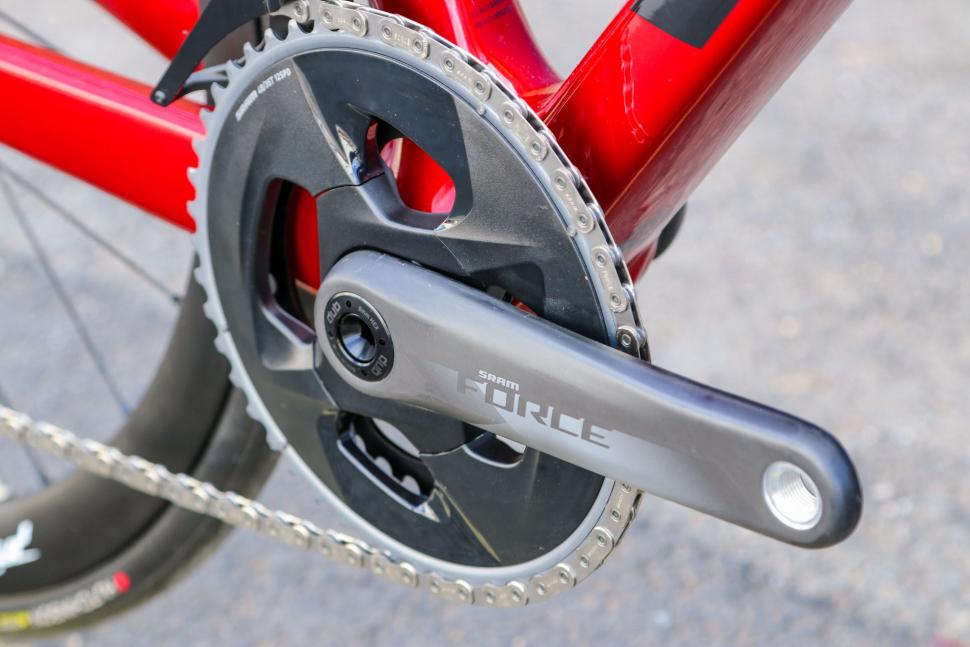


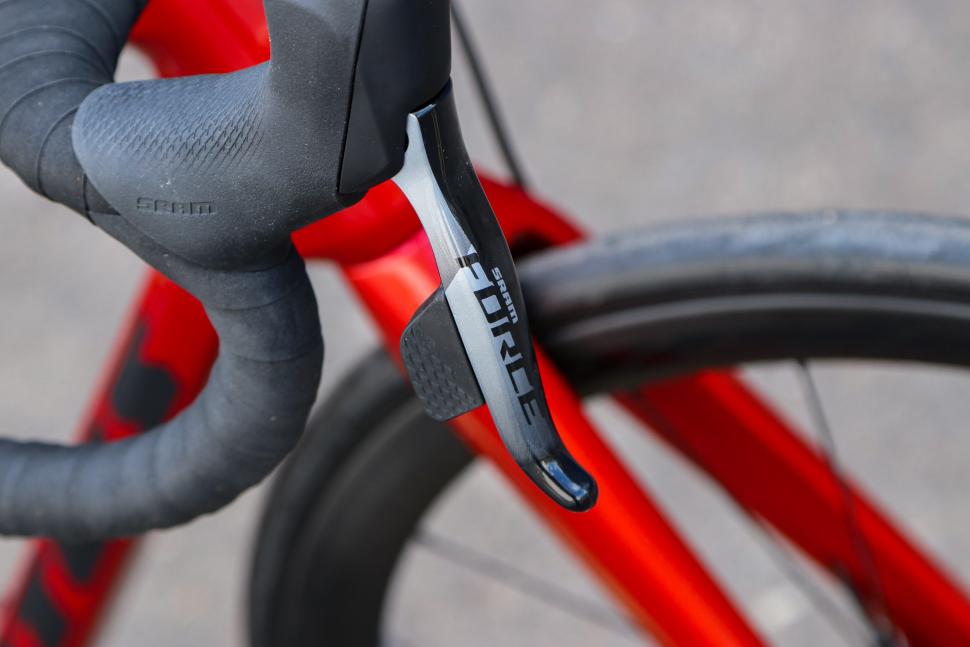



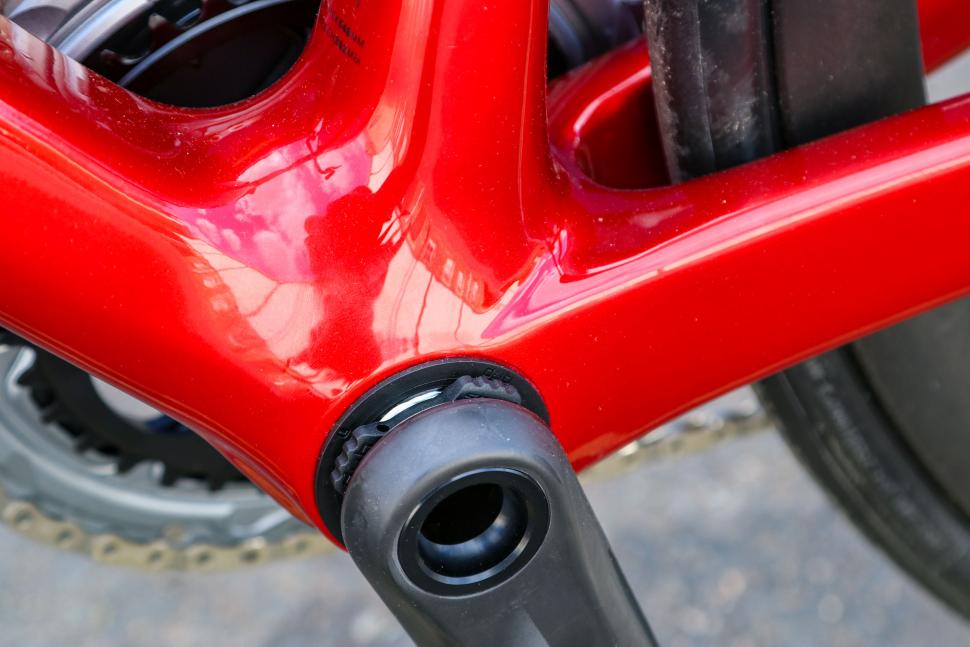
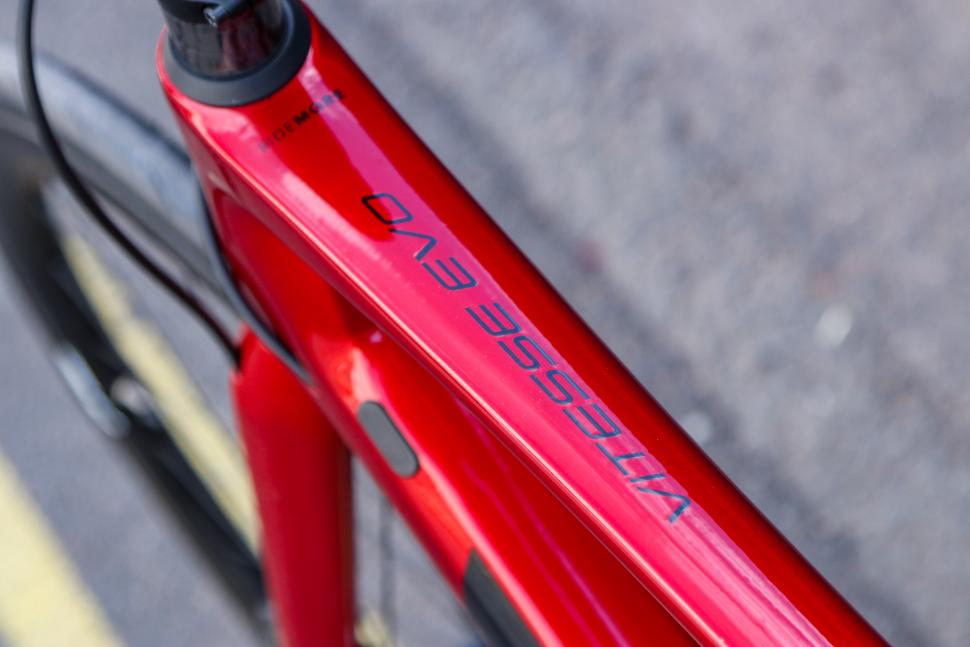



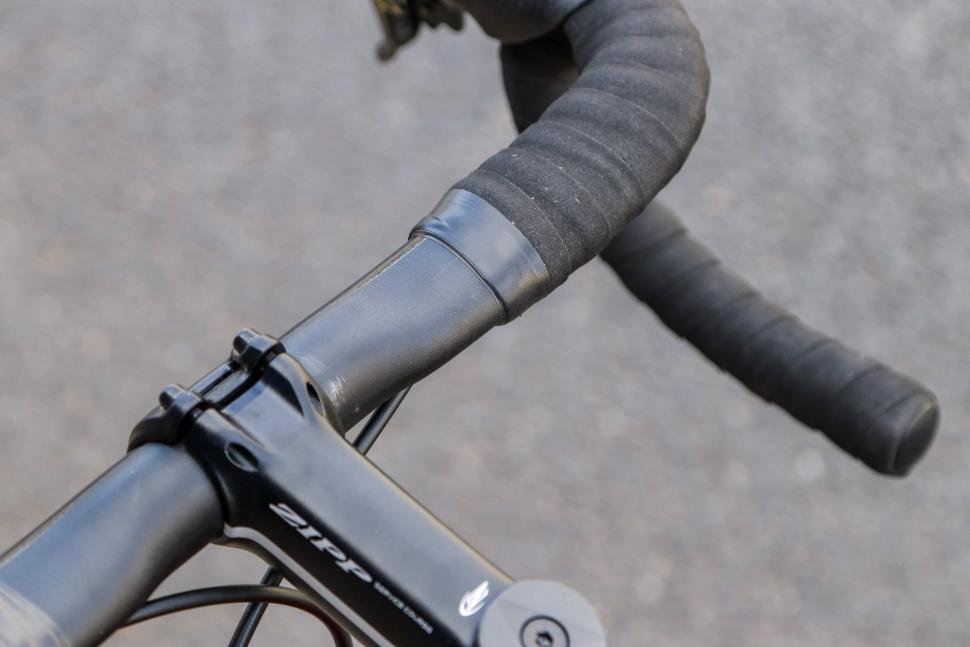
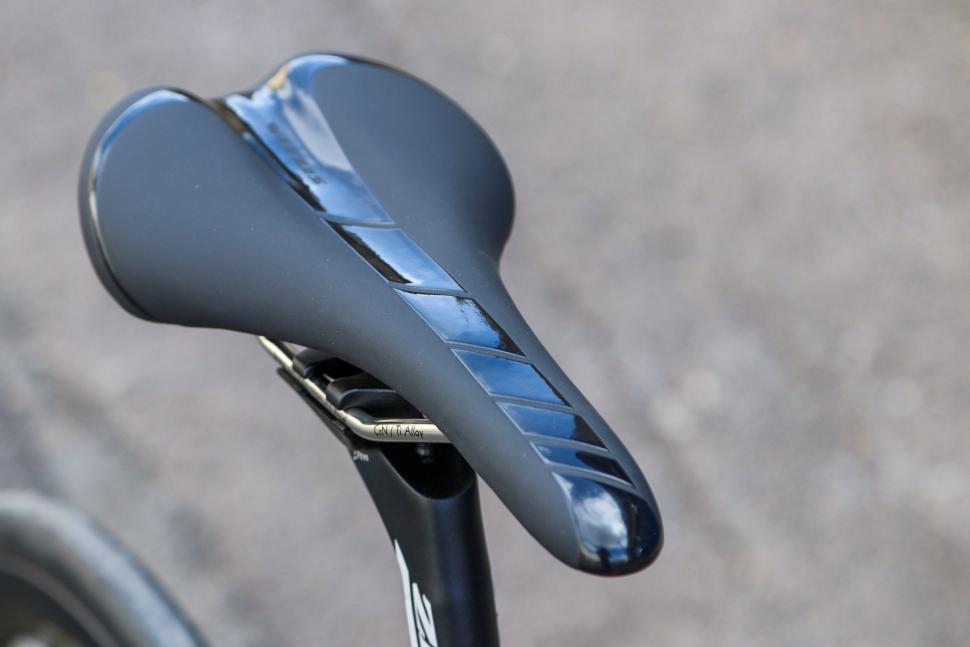
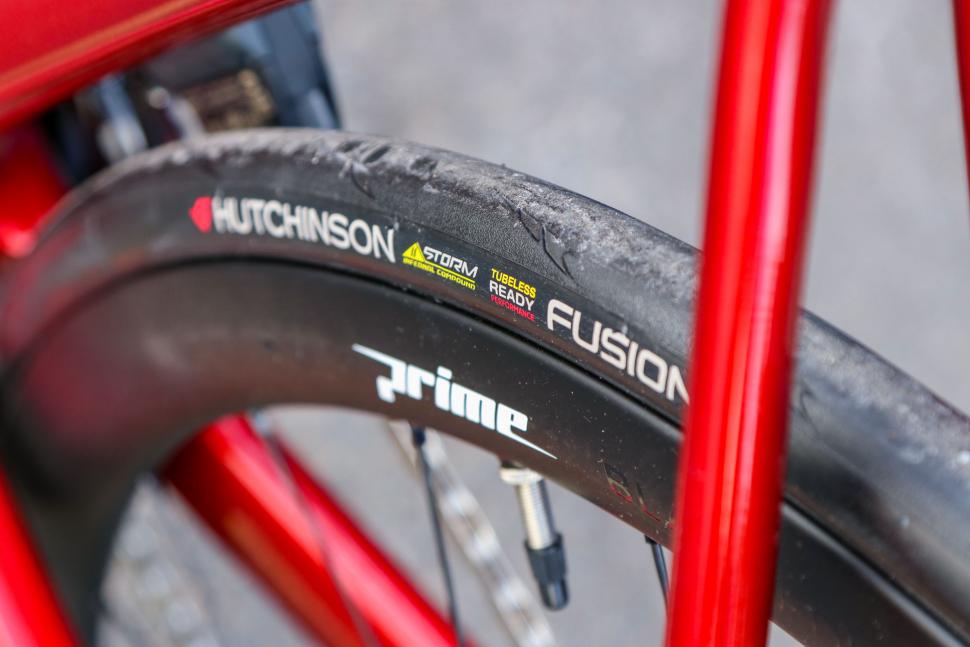

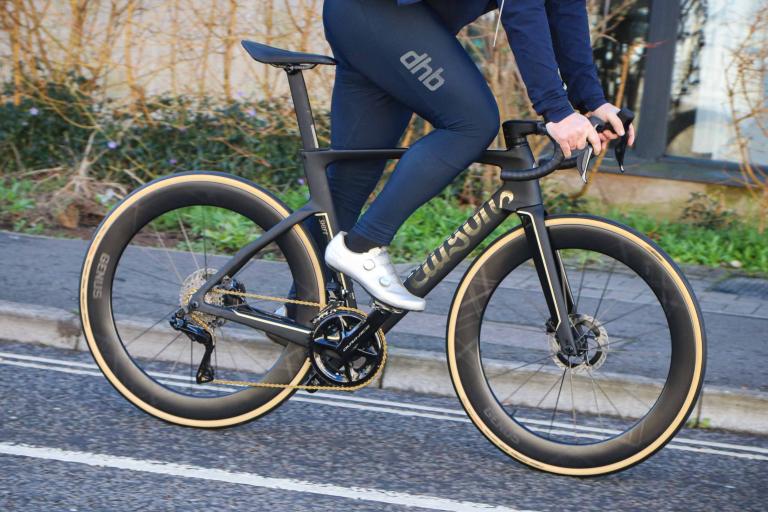
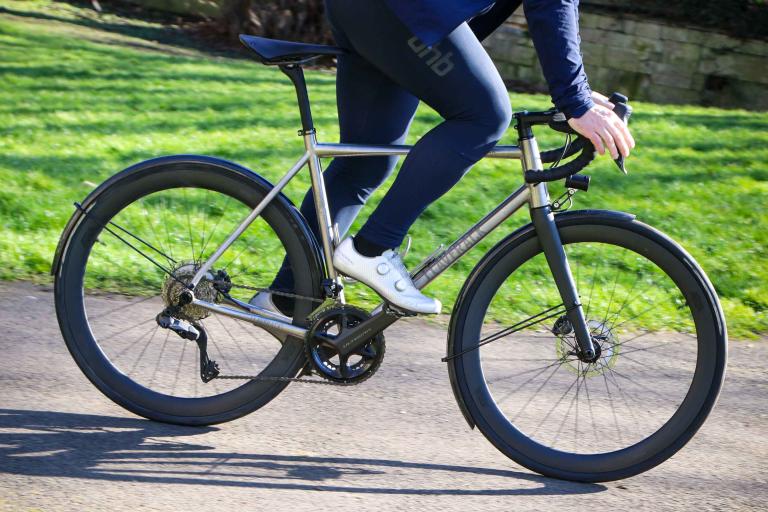

Add new comment
5 comments
> "the fork is full carbon fibre with the steerer tapered to correspond with the oversized head tube. This means the front end feels really tight and direct when steering into technical bends on a descent or when hauling on the front brake for an emergency stop."
How does a tapered steerer and oversized headtube contribute in any way to the steering? Surely the steerer is tapered because the headtube is oversize, and for no other reason? It's still fixed firmly by two sets of bearings, just like any other bicycle.
Surely the steering geometry is the determing factor in how the bicycle rides when turning and braking - not the bearing design?
>"Vitus has managed to achieve a decent level of comfort in the frame and fork"
The vast majority of road buzz comes through the tyres and it is they that determine how much vibration enters the frame?
>"and the seatstays are noticeably thinner than the rest of the frame to provide some flex and comfort to the rear end of the frame."
Unless you're suggesting that the seatstays actually compress when riding, this seems like nonsense. The only movement in the seatstays will be lateral.
I see what you're getting at PPPL, that it's just uncritical regurgitation of marketing bollocks. However, I've changed my frame several times and have found really quite stark differences in ride comfort, despite no change in wheels, tyres and contact points; perhaps the most surprising being a switch from an expensive Van Nic Ti number to a cheap, aluminium Kinesis, which was way comfier.
So, the frameset must have quite a big impact on ride quality, even if the seatstays don't compress longitudinally.
Point 1) these things flex the beefier the section the less they flex.
Point 2 ) as above but to you point yes they steering is defined by the geometry but if the front end isn't stiff the fork and frame will flex and go away from that ideal geometry more than is desired.
Point 3) again they flex. The chainstay deflects up and reacts against seatstays which flex.
Bikes are amazingly flexible, how the designers tune that flex has a massive effect on the steering, ride comfort, etc.
So if these components flex it should be measurable. And these manufacturers will provide these measurements, right?
Right?
Otherwise it's just meaningless bollocks. The human body isn't a reliable measuring tool.
I previously owned this frame, albeit with Ultegra Di2 rather than SRAM AXS. It was superb. Light, stiff, fast, comfortable, reactive. I crashed it following a front tyre blowout and the seatstay snapped. No fault of the frame!
It seems rather harsh to criticise the bike for it's saddle and handlebars since the saddle is likely to be one of the first things that buyers will change, especially people buying a bike of this magnitude and spec, which is clearly aimed at someone who knows what they're doing!
I'd highly recommend the bike.